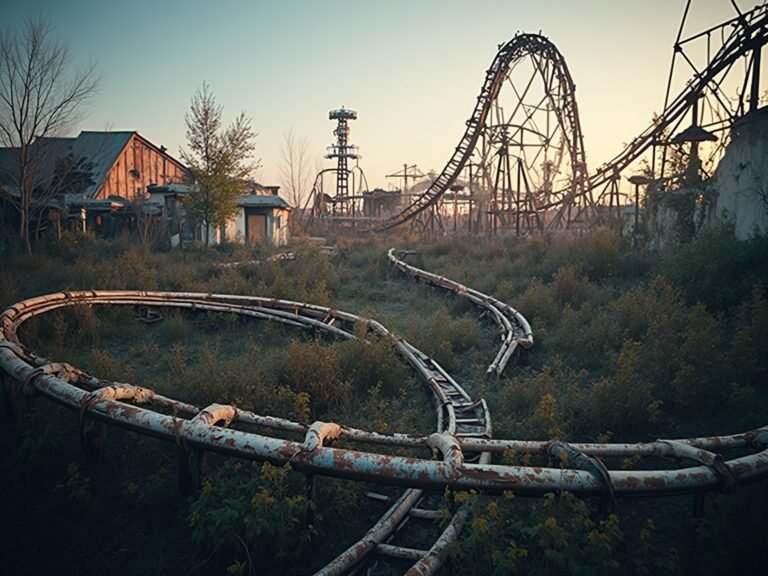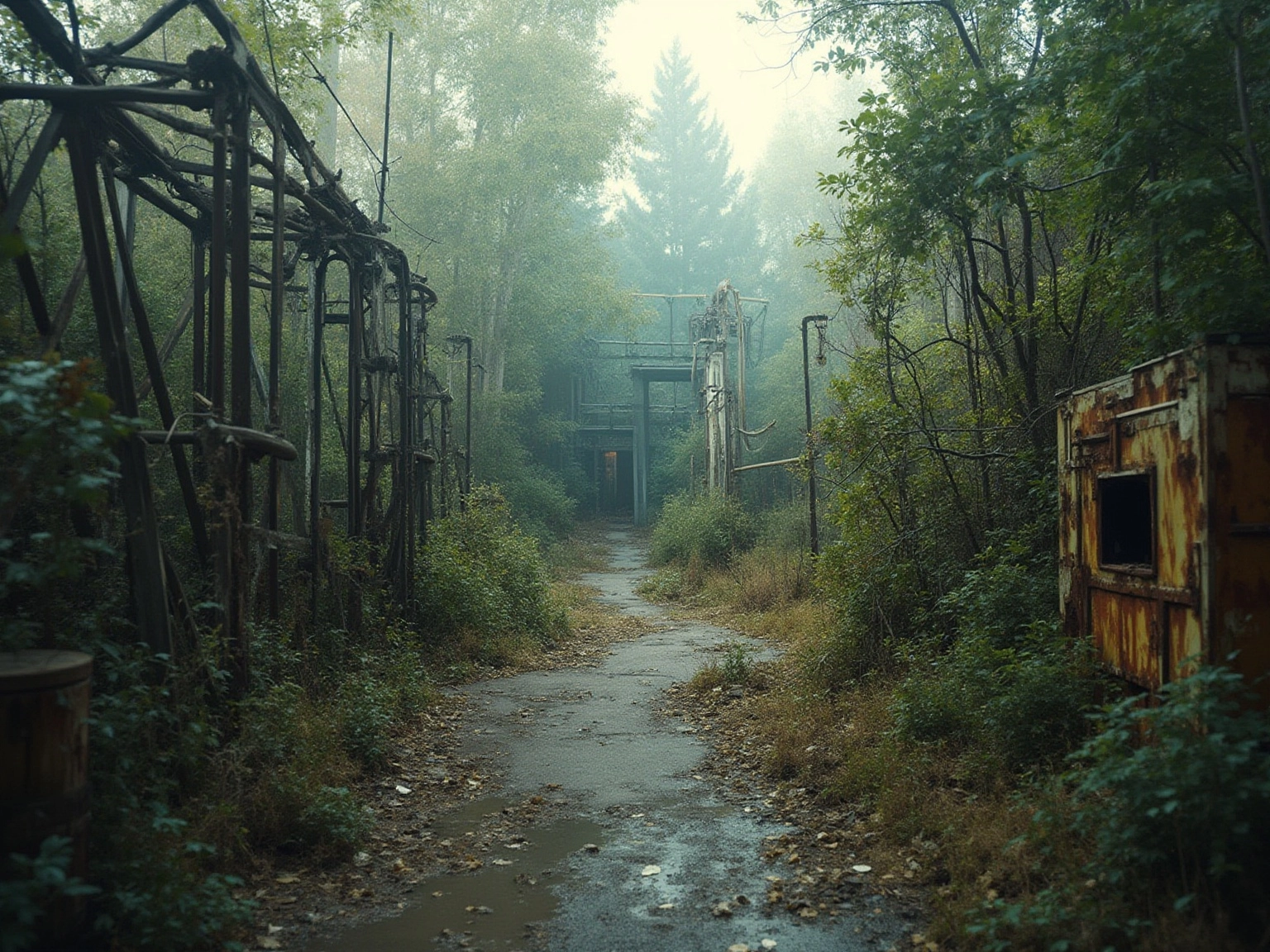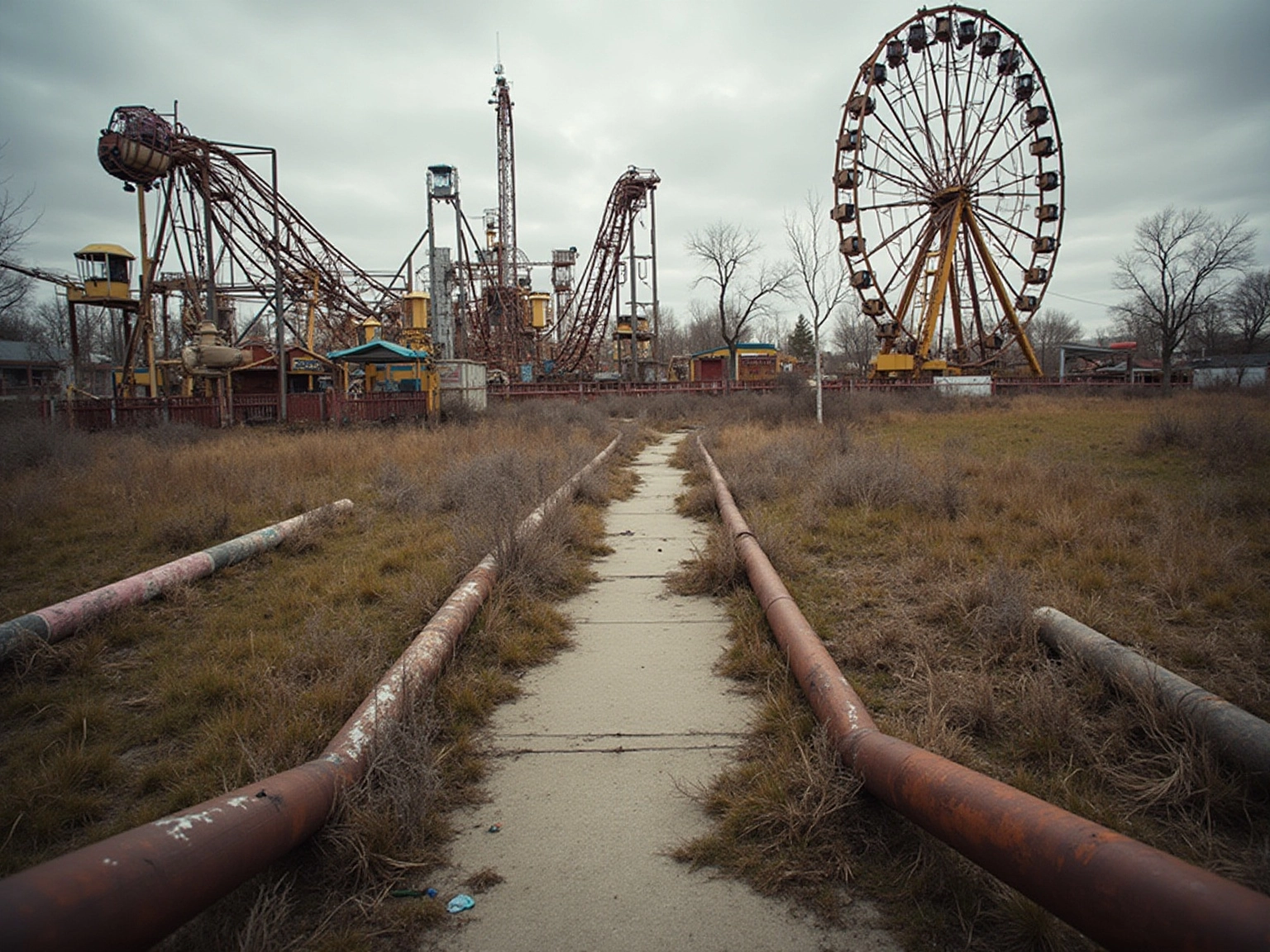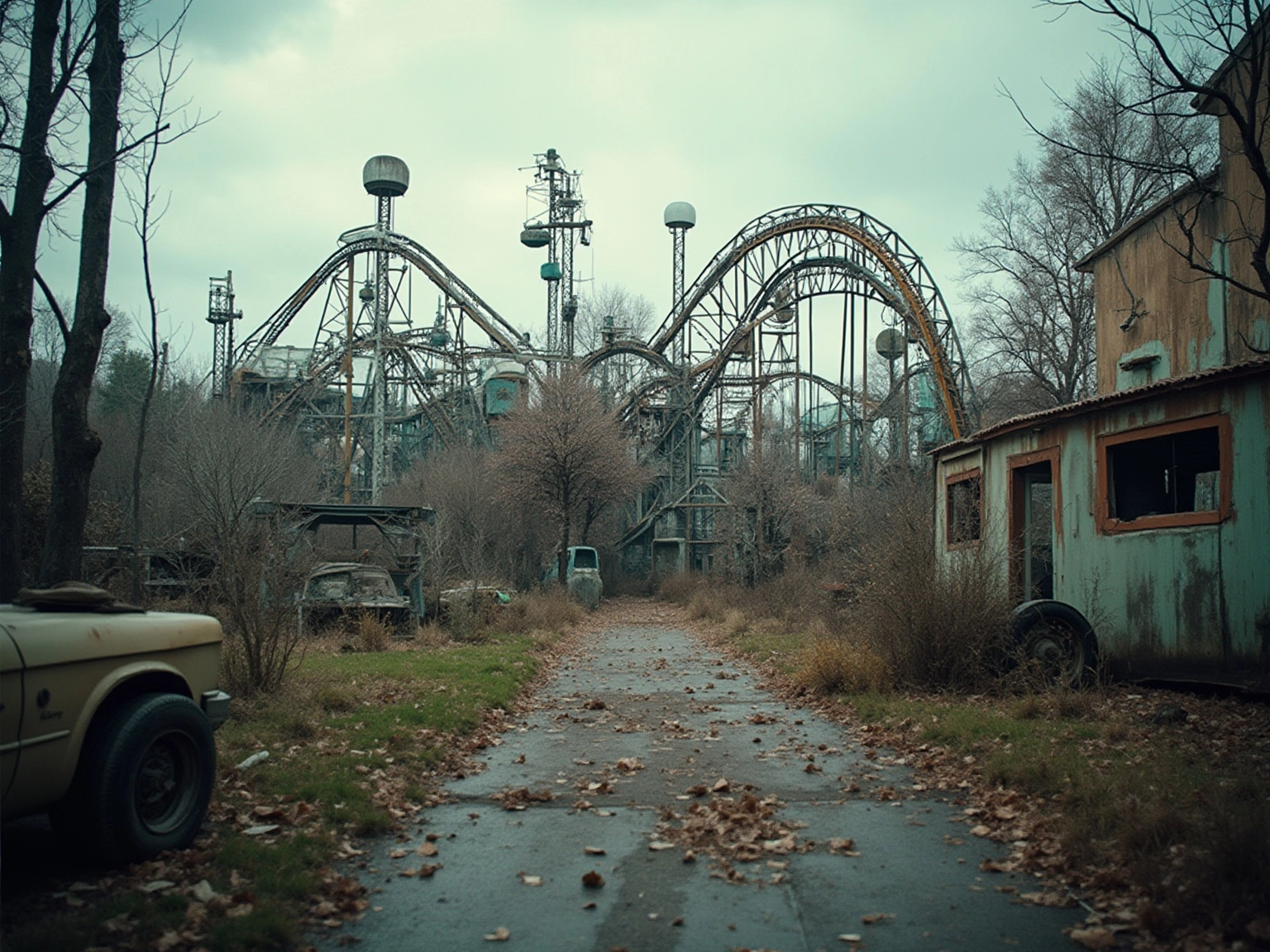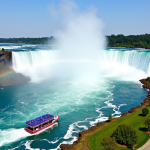Overview
Abandoned theme parks are like hidden treasures waiting to be discovered! These neglected amusement venues evoke a sense of nostalgia and curiosity, drawing urban explorers and photographers alike with their haunting beauty and unique histories.
Imagine wandering through these forgotten spaces, where nature is reclaiming what was once human-made. It’s not just about the thrill of exploration; these sites spark conversations about environmental sustainability and the cultural narratives that shape our community identities.
Isn’t that fascinating? You might find yourself reflecting on how these places mirror broader societal changes, all while enjoying the thrill of uncovering their stories!
Key Highlights:
- Abandoned theme parks are relics of the past, attracting urban explorers and photographers due to their haunting beauty and rich narratives.
- Approximately 300 abandoned theme parks exist worldwide, each with unique stories reflecting societal changes.
- These sites symbolize nature’s reclamation of human spaces, prompting discussions on environmental issues and sustainability.
- The history of amusement parks shows a rise in popularity post-World War II, with significant closures due to economic factors and competition.
- Urban exploration, or ‘urbex,’ has gained popularity, with 1.5 million explorers visiting abandoned parks annually, emphasizing ethical considerations in preservation.
- Revitalization efforts are underway to transform abandoned parks into community spaces, enhancing local economies and cultural identity.
- Abandoned parks evoke nostalgia and can influence community pride, but they also risk symbolizing decline and neglect.
- The portrayal of abandoned theme parks in media and art reflects broader societal themes, igniting public interest and curiosity.
Introduction
Abandoned theme parks are captivating remnants of a vibrant past, where laughter and excitement once echoed through their now-silent grounds! These sites, often cloaked in an eerie beauty, serve as powerful symbols of nostalgia and the relentless passage of time. Did you know there are an estimated 300 such parks scattered across the globe? Each one tells a unique story of decline and decay, inviting urban explorers and photographers like you to uncover the rich narratives embedded within their rusting rides and overgrown pathways.
As we grapple with themes of loss and environmental reclamation, exploring these forgotten amusement venues not only highlights the socio-economic factors that led to their abandonment but also prompts a deeper reflection on the cultural significance these spaces hold. Through the lens of urban exploration, these parks emerge as poignant reminders of our collective history. They urge us to connect with the past while inspiring discussions about preservation and revitalization for future generations. So, are you ready to discover the stories waiting to be uncovered in these fascinating places?
Understanding Abandoned Theme Parks: An Overview
Abandoned theme parks are more than just closed amusement venues; they’re poignant relics of a bygone era, often left to decay in hauntingly beautiful states. These sites evoke nostalgia and curiosity, drawing in urban explorers, photographers, and history enthusiasts alike. The allure of these recreational areas, especially the abandoned theme park, lies not only in their eerie aesthetics but also in the rich narratives they embody, reflecting the rise and fall of entertainment venues that once thrived in vibrant communities.
Did you know there are approximately 300 abandoned theme parks around the world? Each one has its own distinctive story to tell! From overgrown roller coasters to rusting Ferris wheels, these locations serve as powerful reminders of the passage of time and shifting societal interests. For instance, the Packard Automotive Plant in Detroit and the Chernobyl Nuclear Power Plant have become hotspots for urban exploration, illustrating a broader cultural fascination with decay and the remnants of human activity.
But the significance of these abandoned sites goes beyond mere exploration; they symbolize nature’s reclamation of spaces once dominated by human creativity and commerce. This reclamation serves as a metaphor for environmental issues and the consequences of our actions, prompting reflection on sustainability and preservation—core themes that The Design Tourist emphasizes. As Karen LeBlanc, the creator of The Design Tourist, notes, “What distinguishes The Design Tourist from other travel blogs is its focus on creativity and connection,” a viewpoint that resonates profoundly when exploring these forgotten amusement venues.
The Design Tourist is a fantastic resource for those looking to connect with these compelling stories, bridging travel, design, and cultural experiences. Recent trends in urban exploration highlight a growing interest in these sites, with enthusiasts documenting their adventures and sharing insights into the historical significance of these locations. The narratives behind these areas often unveil the socio-economic factors that contributed to their decline, making them not just sites of adventure but also significant cultural artifacts.
As urban explorers delve into these neglected spaces, they uncover layers of history that resonate with a desire for adventure and freedom in an increasingly constrained urban landscape. Exploring an abandoned theme park becomes a journey through time, offering a unique perspective to appreciate the stories of decline and resilience that define our shared history. Recognized with NATJA Gold and Bronze Awards for excellence in travel journalism, The Design Tourist emphasizes the importance of immersive creative exploration, including authentic accommodations and local art, enriching the experience of discovering these fascinating sites.
The Rise and Fall of Theme Parks: A Historical Perspective
The history of amusement venues is a fascinating journey filled with creativity and ups and downs! Emerging in the late 19th century, these venues evolved from simple pleasure gardens into intricate themed environments that truly captivated visitors. After World War II, we saw a thrilling boom in theme recreation construction, with Disneyland leading the way and setting a standard for immersive experiences that would shape the industry for years to come.
But this golden age hasn’t come without its challenges. Economic downturns, shifting consumer preferences, and rising operational costs have led to the closure of many beloved recreational areas. For example, falls accounted for 90 of the 149 total workplace accidents at Disney World from 2015 to 2020, underscoring the operational risks that can impact the viability of these venues.
Between 2014 and 2019, Six Flags locations reported 15 workplace incidents, resulting in 13 hospitalizations and 3 amputations. This really highlights the difficulties that amusement attractions face.
Moreover, factors like natural disasters and financial mismanagement have played crucial roles in the abandonment of attractions, including some once-popular theme parks. Historical case studies reveal that many recreational areas have struggled against competition from larger entertainment venues, which offer a wider array of attractions and experiences. Interestingly, the amusement and theme attractions industry employed 203,361 individuals in 2023, reflecting a 23% increase in jobs since 2013. The largest employment gains occurred in 2021 and 2022, showcasing a recovery from the significant decline in 2020 due to the COVID-19 pandemic.
Yet, amidst this growth, we must acknowledge the closures of legendary recreational areas, including those abandoned theme parks that once drew in millions.
The evolution of entertainment venues over time illustrates a complex interplay of economic factors and cultural shifts. As Karen LeBlanc, creator of The Design Tourist, beautifully puts it, “By combining expert storytelling with practical travel advice, The Design Tourist empowers readers to explore the world with a creative lens.” Understanding the historical context of amusement venues and their decline offers valuable insights into the future of entertainment and leisure.
The Allure of Abandonment: Nostalgia and Aesthetics
The abandoned theme park is a fascinating spot that blends nostalgia and melancholy, drawing in visitors who are eager to reconnect with the past. Just imagine the vibrant colors slowly giving way to rust and decay—it’s a hauntingly beautiful scene that captivates photographers and artists alike! This charm is amplified by the echoes of joy and excitement that once filled the park, now softly replaced by silence and nature’s gentle reclamation.
You might find yourself reflecting on loss, memory, and the unstoppable passage of time as you wander these grounds. They transform into powerful symbols of cultural history and personal nostalgia.
Did you know that nostalgia can actually boost your mood and reduce stress? Research shows that revisiting happy memories releases dopamine, making you feel good! As Sedikides et al. put it, “nostalgia is considered an emotion, and a predominantly positive one at that.” This emotional pull is particularly strong in abandoned theme parks, where the remnants of past happiness encourage you to contemplate your own experiences.
Photographic case studies reveal how these locations serve as a canvas for capturing beauty in decay. Just think about the intricate details of rusting rides and overgrown pathways—they’re stunning!
The visual appeal of these sites has sparked a growing trend in photography, with enthusiasts eager to capture the unique charm of deserted places. Photographers often share how these environments evoke deep emotional responses, and it’s clear that nostalgia plays a significant role in conversations about cultural heritage. Exploring deserted recreational sites offers a rich tapestry of stories waiting to be uncovered, inviting you to appreciate the narratives woven into their very essence.
Interestingly, the average six-letter words per response in discussions about these places can shape how nostalgia is portrayed. It suggests that language and word choice are key in forging emotional connections. Plus, the case study titled “Limitations and Future Directions in Nostalgia Research” highlights the need for longitudinal studies to deepen our understanding of nostalgia across different age groups and cultures, enriching the dialogue around these evocative locations.
Urban Exploration: The Adventure of Discovering Abandoned Parks
Urban exploration, or ‘urbex’ as it’s often called, has become quite the adventure! This subculture is all about uncovering hidden and neglected spots, including those fascinating abandoned theme parks. In 2025, this trend has really taken off, with around 1.5 million urban explorers visiting these magical places each year. The thrill of discovery and the chance to capture stunning photos and stories draws many to these sites. Engaging with history in this way allows you to connect with the past, deepening your appreciation for the stories embedded in these once-vibrant spaces.
But hold on—while the allure of urban exploration is exciting, it does come with some important ethical considerations. It’s essential to navigate the fine line between appreciation and exploitation. Trespassing raises questions about how we preserve these locations. Experts suggest that urban exploration can indeed raise awareness of historical significance, but it also requires a commitment to ethical practices.
This means respecting property rights and advocating for the preservation of these sites instead of contributing to their decline. Efforts to establish community standards have shown to be effective, emphasizing how vital it is to promote responsible exploration.
If you’re gearing up for some urban photography, especially in bustling places like New York City, I’ve got some essential tips for you!
- Planning your outfits ahead of time can help you blend into the environment.
- Thinking about logistics for moving between locations is key—especially in crowded areas.
- Early mornings are often your best bet for capturing less crowded shots.
- Don’t forget that many national reserves and similar sites require permits for professional photography, so checking local regulations and securing those permits in advance is crucial.
Adding traditional attire or local symbols can really enhance the cultural vibe of your photos, making your storytelling even richer. You might also consider bringing along fun props like balloons, bicycles, or even your pet to add a personal touch and make your photos truly memorable.
Let’s dive into some fascinating case studies that highlight the intricacies of urban exploration in abandoned theme parks. Take the former Six Flags New Orleans, for example. Exploring this site reveals not just the physical decay but also the vibrant stories of the communities that once thrived there. Urban explorers often share their journeys, stressing the importance of documenting these spaces with care.
As one urban explorer beautifully put it, “Every abandoned green space tells a story, and it’s our duty to honor that story while ensuring its future.” This sentiment echoes the growing global appreciation for culture, much like the rise of Korean cuisine, which emphasizes respecting the history and narratives of the places we discover.
As urban exploration continues to evolve, it’s crucial for enthusiasts like you to thoughtfully navigate these ethical dilemmas. Your passion for discovery should never come at the expense of the very history you aim to celebrate. Megan Brophy, the Vice President of Marketing at Abercrombie & Fitch, noted, “Gen Z is definitely very direct. They’re very transparent. They want realness. They want authenticity.” This desire for genuine experiences drives urban explorers, making it all the more important to approach your adventures with respect and responsibility.
Notable Abandoned Theme Parks: Case Studies from Around the Globe
Abandoned theme parks around the globe have transformed into touching symbols of nostalgia and the passage of time. Take Six Flags New Orleans, for instance—left in ruins after the devastation of Hurricane Katrina. This site stands as a stark reminder of nature’s overwhelming power and the vulnerability of our creations.
The economic impact of the hurricane on the area was profound, leading to its permanent closure and leaving behind a haunting landscape that echoes with the laughter and joy once experienced within its gates. Reports indicate that the aftermath of Hurricane Katrina not only affected the area but also underscored the broader implications for cultural sites in the region.
Similarly, the Land of Oz in North Carolina, originally designed as a whimsical tribute to L. Frank Baum’s beloved tale, now lies in decay, overtaken by the encroaching forest. This area, once vibrant with color and life, reflects themes of loss and the fleeting nature of entertainment. Each abandoned theme park tells a unique story, showcasing the emotional connections that visitors once held and the memories that linger long after the rides have stopped.
These case studies not only highlight the physical deterioration of these sites but also invite us to reflect on the cultural narratives they embody. As travel journalist Karen LeBlanc, host of The Design Tourist, puts it, “By combining expert storytelling with practical travel advice, The Design Tourist empowers readers to explore the world with a creative lens.” This perspective encourages us to uncover the deeper significance of what these areas represented to their communities and the lasting influence they hold on our collective memory.
Just like the Great Salt Lake City Yoga Festival inspires community and wellness, these neglected spaces evoke a sense of connection and nostalgia, reminding us of the joy and creativity they once nurtured.
Revitalization Efforts: Breathing New Life into Abandoned Parks
In recent years, revitalization initiatives for deserted amusement venues have really taken off! These once-neglected spots are being transformed into vibrant community spaces and attractions that everyone can enjoy. A fantastic example is the redevelopment of the former Six Flags New Orleans location, which is being reimagined as a mixed-use development complete with sports fields and recreational areas. Not only does this breathe new life into a once-thriving amusement area, but it also honors its historical significance—creating a beautiful bridge between the past and future.
Did you know that successful redevelopment projects can significantly boost local economies and enhance community well-being? For instance, a study in Austin, Texas, found that blocks with unsecured vacant buildings had way more drug calls, theft calls, and violent calls compared to those without. This connection really highlights how important it is to transform neglected sites into functional community hubs. Revitalized spaces can lead to lower crime rates and improved mental health outcomes among residents, as shown in the case study titled ‘Neighborhood Deterioration and Mental Health.’
Urban planners emphasize the many benefits of repurposing these spaces. By engaging local communities in the redevelopment process, projects can foster a sense of ownership and pride, ultimately leading to sustainable engagement and tourism. Experts, like Chuck Sams, National Park Service Director, point out that private investments in historic preservation can breathe new life into these areas, turning them into affordable housing, creative spaces, and recreational centers.
As revitalization projects continue to emerge in 2025, the focus remains on creating inclusive environments that reflect the community’s needs while preserving the memories of what once was. The transformation of neglected amusement venues into thriving community spaces not only revitalizes the physical landscape but also enriches the cultural fabric of the area. These spaces are becoming valuable assets for future generations, and it’s exciting to see how they evolve!
Cultural Reflections: The Impact of Abandoned Parks on Communities
Abandoned theme parks can have a fascinating impact on their surrounding communities, showcasing a mix of nostalgia and neglect. These intriguing spots often stir up local pride, drawing in urban explorers and curious tourists who are captivated by their unique histories. This influx of visitors can give a nice boost to the local economy, as they support nearby businesses and engage with the community.
Yet, it’s important to acknowledge that an abandoned theme park can also symbolize decline, potentially leading to increased crime and vandalism, which can undermine community safety and unity.
The effects of these sites reach far beyond just economics; they spark conversations about community identity and heritage. For many, these deserted amusement venues serve as poignant reminders of a shared past, reflecting the values and aspirations of the communities they inhabit. This duality is especially striking in areas where the theme park once thrived, evoking memories of joy and togetherness while also highlighting the challenges of preservation and revitalization.
Did you know that community pride can be significantly shaped by the presence of these neglected locations? Communities with a strong sense of identity often view these spaces as vital to their cultural narrative, nurturing a collective memory that can enhance local engagement. On the flip side, the neglect of these spaces, like the abandoned theme park, can foster feelings of abandonment and disconnection among residents, complicating their ties to the area.
A striking statistic reveals that 69% of youth who reported past housing instability engaged in self-harm in the last year, compared to 49% of those who hadn’t faced such instability. This underscores the broader implications of community identity and pride.
Take, for instance, the case study of the Charles County Sheriff’s Office, which illustrates how community identity evolves and how local institutions tackle issues related to neglected sites. Sheriff Troy Berry emphasizes, “The CCSO remains committed to our goal of serving Charles County at the highest level,” highlighting the importance of community service and safety in relation to the challenges posed by the abandoned theme park.
Ultimately, abandoned theme parks are more than just remnants of the past; they are dynamic entities that reflect the ongoing evolution of community identity. Their stories are woven into the fabric of local culture, prompting conversations about the significance of preserving these narratives while addressing the challenges they present. The Design Tourist combines expert storytelling with practical travel advice, enhancing your understanding of these complex sites and their importance within the broader context of community identity.
Abandoned Parks in Popular Culture: Media and Artistic Interpretations
The concept of an abandoned theme park has long intrigued creators, filmmakers, and authors, serving as a powerful emblem of nostalgia and loss. These eerie settings have been masterfully employed in films like ‘The Florida Project,’ which beautifully juxtaposes childhood innocence against a backdrop of decay. Horror movies also exploit the unsettling atmosphere of deserted attractions to evoke fear and suspense. Plus, the artistic lens of photographers like Seph Lawless amplifies public intrigue with haunting images that capture the desolation and beauty of these forgotten spaces.
Take, for instance, the abandoned theme park Wonderland in Beijing. It never opened its doors after two phases of halted construction in 1998 and 2008. This example shows how abandoned theme parks can transform into cultural landmarks. The way these locations are depicted in media not only stirs emotions but also reflects broader societal themes. For example, a study examining the impact of zoos and animated programs on public interest in endangered species revealed that visual storytelling significantly influences audience engagement through non-parametric comparative methods, like the Wilcoxon signed-rank test and Mann-Whitney U test.
Isn’t it fascinating how the portrayal of an abandoned theme park in films can ignite curiosity and nostalgia? This results in heightened public interest in these locations. As we look to 2025, the trend of showcasing deserted green spaces in films continues to expand, with filmmakers increasingly drawn to their rich stories and visual possibilities.
Experts point out that these locations often serve as metaphors for lost dreams and the passage of time, resonating deeply with audiences. Artistic interpretations of the abandoned theme park—whether through film, photography, or literature—invite you to reflect on the ephemeral nature of joy and the narratives that linger long after the lights have dimmed. As Karen LeBlanc, travel host and writer for The Design Tourist, puts it, “By combining expert storytelling with practical travel advice, The Design Tourist empowers readers to explore the world with a creative lens.”
This perspective encourages a deeper appreciation for the authenticity and creativity found in these sites. They remind us that they remain a powerful element of popular culture, intertwined with beauty and melancholy in our collective memories. By immersing ourselves in local art and culture, we can better understand the narratives held by the abandoned theme park, unveiling the stories that every destination has to tell.
Conclusion
Abandoned theme parks are like time capsules, inviting you to explore the vibrant stories of the past. They capture a mix of nostalgia and complexity, reminding us of the joy and decline that shape human experience. Each park, from the once-bustling Six Flags New Orleans to the enchanting decay of the Land of Oz, tells a unique tale that sparks curiosity and reflection.
As you wander through these forgotten spaces, you’ll discover not just the beauty in their decay but also the deeper socio-economic stories behind their abandonment. Urban exploration can be thrilling, but it’s essential to engage with these historical sites responsibly. With revitalization efforts gaining traction, there’s a real chance for these parks to evolve from symbols of neglect into lively community hubs, fostering local pride and enriching cultural identity.
Ultimately, these abandoned parks are more than just relics; they carry the stories of the communities that once thrived within their gates. They challenge us to think about our collective past, the societal shifts that have occurred, and the importance of preserving these sites for future generations. By engaging with these spaces, you can connect with history, raise awareness, and inspire conversations about the delicate balance between nostalgia and progress. The narratives woven into the fabric of these parks encourage a deeper appreciation for human creativity and the lasting power of memory.
Frequently Asked Questions
What are abandoned theme parks?
Abandoned theme parks are closed amusement venues that serve as poignant relics of a bygone era, often left to decay in hauntingly beautiful states. They evoke nostalgia and curiosity, attracting urban explorers, photographers, and history enthusiasts.
How many abandoned theme parks are there in the world?
There are approximately 300 abandoned theme parks around the world, each with its own distinctive story.
What do abandoned theme parks symbolize?
Abandoned theme parks symbolize nature’s reclamation of spaces once dominated by human creativity and commerce, serving as a metaphor for environmental issues and prompting reflection on sustainability and preservation.
What role does The Design Tourist play in exploring abandoned theme parks?
The Design Tourist is a resource that connects readers with compelling stories about abandoned theme parks, bridging travel, design, and cultural experiences, and emphasizing the importance of immersive creative exploration.
What historical factors contributed to the decline of amusement venues?
The decline of amusement venues has been influenced by economic downturns, shifting consumer preferences, rising operational costs, competition from larger entertainment venues, natural disasters, and financial mismanagement.
How has the amusement and theme attractions industry changed recently?
The amusement and theme attractions industry employed 203,361 individuals in 2023, reflecting a 23% increase in jobs since 2013, with significant employment gains occurring in 2021 and 2022 as the industry recovered from the decline caused by the COVID-19 pandemic.
What is the significance of urban exploration in relation to abandoned theme parks?
Urban exploration of abandoned theme parks uncovers layers of history, resonating with a desire for adventure and freedom, and offers a unique perspective on the stories of decline and resilience that define shared history.
How do abandoned theme parks connect to broader cultural narratives?
The narratives behind abandoned theme parks unveil socio-economic factors that contributed to their decline, making them significant cultural artifacts that reflect shifting societal interests and the passage of time.








